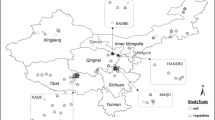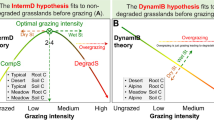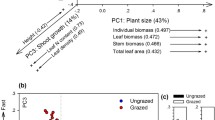Abstract
Aim
We aimed to explore the general response patterns of plant biomass allocation to grazing disturbance and to test two important hypotheses, optimal partitioning and isometric allocation, for explaining potential mechanisms by which grazing controls biomass distribution in an alpine grassland on the Tibetan Plateau.
Methods
We identified 57 relevant papers about grazing on the Tibetan Plateau, from which 366 data sets suitable for the meta-analysis were extracted. Effect sizes were assessed by computing natural log-converted response ratios of response variables. Percentage change relative to control was used for each estimate of grazing effects.
Results
The aboveground biomass, soil water content (SWC), soil organic carbon, soil total nitrogen, and soil total phosphorus significantly decreased with increased grazing intensities, while plant species richness (SR), soil bulk density (SBD) and the ratio of root to shoot exhibited the opposite tendency. Belowground biomass (BGB) showed no significant differences under light and high grazing intensities while apparently increased under moderate grazing intensity (MG) that verifies the biomass transfer hypothesis. BGB was positively related to SBD and SR but was negatively associated with SWC.
Conclusions
The biomass transfer in MG supports the optimal partitioning hypothesis that plants partition biomass among various organs to maximize growth rate responding to environmental stress. The findings suggest that the primary mechanisms leading to the enhancement of BGB in MG are compensatory growth of individual plants, a dwarfing tendency within the plant community, a significant increase in species richness, and changes in soil microbial communities resulting from grazing.







Similar content being viewed by others
References
Bardgett RD, Bowman WD, Kaufmann R, Schmidt SK (2005) A temporal approach to linking aboveground and belowground ecology. Trends Ecol Evol 20:634–641
Bennett JA, Klironomos JN (2018) Climate, but not trait, effects on plant–soil feedback depend on mycorrhizal type in temperate forests. Ecosphere 9
Biondini ME, Patton BD, Nyren PE (1998) Grazing intensity and ecosystem processes in a northern mixed-grass prairie, USA. Ecol Appl 8:469–479
Bloom AJ, Chapin SF, Mooney HA (1985) Resource limitation in plants-an economic analogy. Annu Rev Ecol Evol Syst 16:363–392
Borer ET, Seabloom EW, Gruner DS, Stanley WH, Helmut H, Lind EM, Adler PB, Juan A, Michael TA, Bakker JD (2014) Herbivores and nutrients control grassland plant diversity via light limitation. Nature 508:517–520
Buis GM, Blair JM, Burkepile DE, Burns CE, Chamberlain AJ, Chapman PL, Collins SL, Fynn RWS, Govender N, Kirkman KP (2009) Controls of aboveground net primary production in Mesic savanna grasslands: an inter-hemispheric comparison. Ecosystems 12:982–995
Chapin FS, Bloom AJ, Field CB, Waring RH (1987) Plant responses to multiple environmental FactorsPhysiological ecology provides tools for studying how interacting environmental resources control plant growth. BioScience 37:49–57
Chapin FS, Randerson JT, Mcguire AD, Foley JA, Field CB (2008) Changing feedbacks in the climate–biosphere system. Front Ecol Environ 6:313–320
Chen Y, Lee P, Lee G, Mariko S, Oikawa T (2006) Simulating root responses to grazing of a Mongolian grassland ecosystem. Plant Ecol 183:265–275
Cheng D, Niklas KJ (2007) Above- and below-ground biomass relationships across 1534 forested communities. Ann Bot 99:95–102
CoreTeam R (2016) R: a language and environment for statistical computing. R Foundation for Statistical Computing, Vienna
Denyer JL, Hartley SE, John EA (2010) Both bottom-up and top-down processes contribute to plant diversity maintenance in an edaphically heterogeneous ecosystem. J Ecol 98:498–508
Der Maarel EV, Titlyanova A, Der Maarel EV, Titlyanova A (1989) Above-ground and below-ground biomass relations in steppes under different grazing conditions. Oikos 56:364–370
Diaz S, Cabido MN-MI (2010) Can grazing response of herbaceous plants be predicted from simple vegetative traits? J Appl Ecol 38:497–508
Diaz S, Lavorel S, Mcintyre S, Falczuk V, Casanoves F, Milchunas D, Skarpe C, Rusch G, Sternberg M, Noy-Meir I (2007) Plant trait responses to grazing - a global synthesis. Glob Chang Biol 13:313–341
Dong SK, Wen L, Zhu L, Li X (2010) Implication of coupled natural and human systems in sustainable rangeland ecosystem management in HKH region. Front Earth Sci Chin 4:42–50
Dong Q, Zhao X, Wu G, Chang X (2015) Optimization yak grazing stocking rate in an alpine grassland of Qinghai-Tibetan plateau, China. Environ Earth Sci 73:2497–2503
Dukes JS, Chiariello NR, Cleland EE, Moore LA, Shaw MR, Thayer SS, Tobeck T, Mooney HA, Field CB (2005) Responses of grassland production to single and multiple global environmental changes. PLoS Biol 3
Dyer MI, Deangelis DL, Post WM (1986) A model of herbivore feedback on plant productivity. Bellman Prize Math Biosci 79:171–184
Eldridge DJ, Bowker MA, Maestre FT, Roger E, Reynolds JF, Whitford WG (2011) Impacts of shrub encroachment on ecosystem structure and functioning: towards a global synthesis. Ecol Lett 14:709–722
Enquist BJ, Niklas KJ (2002) Global allocation rules for patterns of biomass partitioning in seed plants. Science 295:1517–1520
Evju M, Austrheim G, Halvorsen R, Mysterud A (2009) Grazing responses in herbs in relation to herbivore selectivity and plant traits in an alpine ecosystem. Oecologia 161:77–85
Fan HB, Wu JP, Liu WF, Yuan YH, Hu L, Cai QK (2015) Linkages of plant and soil C:N:P stoichiometry and their relationships to forest growth in subtropical plantations. Plant Soil 392:127–138
Feng R, Long R, Shang Z, Ma Y, Dong S, Wang Y (2010) Establishment of Elymus natans improves soil quality of a heavily degraded alpine meadow in Qinghai-Tibetan plateau, China. Plant Soil 327:403–411
Foster DR, Swanson FJ, Aber JD, Burke IC, Brokaw N, Tilman D, Knapp AK (2003) The importance of land-use legacies to ecology and conservation. BioScience 53:77–88
Gao YH, Luo P, Wu N, Chen H, Wang GX (2008) Impacts of grazing intensity on nitrogen pools and nitrogen cycle in an alpine meadow on the eastern Tibetan plateau. Appl Ecol Environ Res 6:69–79
Gao YH, Schumann M, Zeng XY, Chen H (2011) Changes of plant communities and soil properties due to degradation of alpine wetlands on the Qinghai-Tibetan plateau. J Environ Prot Ecol 12:788–798
Genard M, Dauzat J, Franck N, Lescourret F, Moitrier N, Vaast P, Vercambre G (2008) Carbon allocation in fruit trees: from theory to modelling. Trees Struct Funct 22:269–282
Groffman PM, Eagan P, Sullivan WM, Lemunyon JL (1996) Grass species and soil type effects on microbial biomass and activity. Plant Soil 183:61–67
Hawkes CV, Sullivan JJ (2001) The impact of herbivory on plants in different resource conditions: a meta-analysis. Ecology 82:2045–2058
Hedges LV, Gurevitch J, Curtis PS (1999) The meta-analysis of response ratios in experimental ecology. Ecology 80:1150–1156
Hilbert DW, Swift DM, Detling JK, Dyer MI (1981) Relative growth rates and the grazing optimization hypothesis. Oecologia 51:14–18
Hou G, Sun J, Wang JN (2018) Dynamics and controls of carbon use efficiency across China's grasslands. Pol J Environ Stud 27:1541–1550
Juenger T, Bergelson J (2000) the evolution of compensation to herbivory in scarlet gilia, Ipomopsis aggregata: herbivore-imposed natural selection and the quantitative genetics of tolerance. Evolution 54:764–777
Kirkman KP (2002) The influence of various types and frequencies of rest on the production and condition of sourveld grazed by sheep or cattle. 2. Vigour. Proceedings of the Annual Congresses of the Grassland Society of Southern Africa 19: 93–105
Klumpp K, Fontaine S, Attard E, Roux XL, Gleixner G, Soussana J (2009) Grazing triggers soil carbon loss by altering plant roots and their control on soil microbial community. J Ecol 97:876–885
Knapp AK, Hoover DL, Blair JM, Buis G, Burkepile DE, Chamberlain A, Collins SL, Fynn RWS, Kirkman KP, Smith MD (2012) A test of two mechanisms proposed to optimize grassland aboveground primary productivity in response to grazing. J Plant Ecol 5:357–365
Li YY, Dong SK, Wen L, Wang X, Wu Y (2014) Soil carbon and nitrogen pools and their relationship to plant and soil dynamics of degraded and artificially restored grasslands of the Qinghai–Tibetan plateau. Geoderma 213:178–184
Liu YS, Pan QM, Liu HD, Bai YF, Simmons M, Dittert K, Han XG (2011) Plant responses following grazing removal at different stocking rates in an Inner Mongolia grassland ecosystem. Plant Soil 340:199–213
Lu X, Yan Y, Sun J, Zhang X, Chen Y, Wang X, Cheng G (2015) Short-term grazing exclusion has no impact on soil properties and nutrients of degraded alpine grassland in Tibet, China. Solid Earth 6:1195–1205
Lu X, Wang L, McCabe MF (2016) Elevated CO2 as a driver of global dryland greening. Sci Rep 6:20716
Ma WH, Yang YH, He JS, Zeng H, Fang JY (2008) Above- and belowground biomass in relation to envi-ronmental factors in temperate grasslands, Inner Mongolia. Sci Chin-Life Sci 51:263–270
Ma WL, Shi PL, Li WH, He YT, Zhang XZ, Shen ZX, Chai SY (2010) Changes in individual plant traits and biomass allocation in alpine meadow with elevation variation on the Qinghai-Tibetan plateau. SciChin-Life Sci 53:1142–1151
Mccarthy MC, Enquist BJ (2007) Consistency between an Allometric approach and optimal partitioning theory in global patterns of plant biomass allocation. Funct Ecol 21:713–720
Mcnaughton SJ (1979) Grazing as an optimization process: grass-ungulate relationships in the Serengeti. Am Nat 113:691–703
Mcnaughton SJ (1983) Compensatory plant growth as a response to herbivory. Oikos 40:329
Mcnaughton SJ, Oesterheld M, Frank DA, Williams KJ (1989) Ecosystem-level patterns of primary productivity and herbivory in terrestrial habitats. Nature 341:142–144
Mcsherry ME, Ritchie ME (2013) Effects of grazing on grassland soil carbon: a global review. Glob Chang Biol 19:1347–1357
Milchunas DG, Lauenroth WK (1993) Quantitative effects of grazing on vegetation and soils over a global range of environments. Ecol Monogr 63:327–366
Mokany K, Raison RJ, Prokushkin AS (2006) Critical analysis of root : shoot ratios in terrestrial biomes. Glob Chang Biol 12:84–96
Müller I, Schmid B, Weiner J (2000) The effect of nutrient availability on biomass allocation patterns in 27 species of herbaceous plants. Perspect Plant Ecol Evol Syst 3:115–127
Ni J (2002) Carbon storage in grasslands of China. J Arid Environ 50:205–218
Osem Y, Perevolotsky A, Kigel J (2010) Grazing effect on diversity of annual plant communities in a semi-arid rangeland: interactions with small-scale spatial and temporal variation in primary productivity. J Ecol 90:936–946
Piao SL, Tan K, Nan H, Ciais P, Fang JY, Tao W, Vuichard N, Zhu B (2012) Impacts of climate and co2 changes on the vegetation growth and carbon balance of Qinghai–tibetan grasslands over the past five decades. Glob Planet Chang 98:73–78
Rashid M, Mujawar LH, Shahzad T, Almeelbi T, Ismail IMI, Oves M (2016) Bacteria and fungi can contribute to nutrients bioavailability and aggregate formation in degraded soils. Microbiol Res 183:26–41
Rautio P, Huhta A, Piippo S, Tuomi J, Juenger T, Saari M, Aspi J (2005) Overcompensation and adaptive plasticity of apical dominance in Erysimum strictum (Brassicaceae) in response to simulated browsing and resource availability. Oikos 111:179–191
Roa-Fuentes LL, Campo J, Parra-Tabla V (2012) Plant biomass allocation across a precipitation gradient: an approach to seasonally dry tropical Forest at Yucatán, Mexico. Ecosystems 15:1234–1244
Rosenburg MS, Adams DC, Gurevitch J (2000) Metawin. Statistical software for meta-analysis, version 2
Shipley B, Meziane D (2002) The balanced-growth hypothesis and the allometry of leaf and root biomass allocation. Funct Ecol 16:326–331
Stahlheber KA, D’Antonio CM (2013) Using livestock to manage plant composition: a meta-analysis of grazing in California Mediterranean grasslands. Biol Conserv 157:300–308
Stowe KA, Marquis RJ, imms HEL (2000) The evolutionary ecology of tolerance to consumer damage. Annu Rev Ecol Syst 31: 565–595
Strauss SY, Agrawal AA (1999) The ecology and evolution of plant tolerance to herbivory. Trends Ecol Evol 14:179–185
Sun J, Wang HM (2016) Soil nitrogen and carbon determine the trade-off of the above- and below-ground biomass across alpine grasslands, Tibetan plateau. Ecol Indic 60:1070–1076
Sun J, Cheng G, Li W (2013) Meta-analysis of relationships between environmental factors and aboveground biomass in the alpine grassland on the Tibetan plateau. Biogeosciences 10:1707–1715
Sun J, Wang X, Cheng G, Wu J, Hong J, Niu S (2014) Effects of grazing regimes on plant traits and soil nutrients in an alpine steppe, northern Tibetan plateau. PLoS One 9:e108821
Sun J, Niu SL, Wang JN (2017) Divergent biomass partitioning to aboveground and belowground across forests in China. J Plant Ecol:1–9. https://doi.org/10.1093/jpe/rtx021
Sun J, Ma BB, Lu XY (2018) Grazing enhances soil nutrient effects: trade-offs between above and below-ground biomass in Alpine grasslands of the Tibetan plateau. Land Degrad Dev 29:770
Sun J, Zhang ZC, Dong SK (2019) Adaptive management of alpine grassland ecosystems over Tibetan plateau. Pratacult Sci 36:1–6. https://doi.org/10.11829/j.issn.1001-0629.2019-0224
Villnas A, Norkko J, Hietanen S, Josefson AB, Lukkari K, Norkko LA (2013) The role of recurrent disturbances for ecosystem multifunctionality. Ecology 94:2275–2287. https://doi.org/10.2307/23597376
Wan HW, Bai YF, Schönbach P, Gierus M, Taube F (2011) Effects of grazing management system on plant community structure and functioning in a semiarid steppe: scaling from species to community. Plant Soil 340:215–226
Wang CT, Wang QJ, Long RJ, Jing ZC, Shi HL (2004) Changes in plant species diversity and productivity along an elevation gradient in an alpine meadow. Acta Phytoecol Sin 28:240–245
Wang G, Wang Y, Kubota J (2006) Land-cover changes and its impacts on ecological variables in the headwaters area of the Yangtze River, China. Environ Monit Assess 120:361–385
Wang XX, Dong SK, Gao QZ, Zhou HK, Liu SL, Su XK, Li YY (2014) Effects of short-term and long-term warming on soil nutrients, microbial biomass and enzyme activities in an alpine meadow on the Qinghai-Tibet plateau of China. Soil Biol Biochem 76:140–142
Wang YX, Sun YI, Wang ZF, Chang SH, Hou FJ (2018) Grazing management options for restoration of alpine grasslands on the Qinghai-Tibet plateau. Ecosphere 9
Wardle DA (2010) Communities and ecosystems. Linking the aboveground and belowground components. Aust Ecol 29:358–359
Wardle DA, Bardgett RD, Klironomos JN, Setala H, Der Putten WHV, Wall DH (2004) Ecological linkages between aboveground and belowground biota. Science 304:1629–1633
Wu GL, Du GZ, Liu ZH, Thirgood S (2009) Effect of fencing and grazing on a Kobresia-dominated meadow in the Qinghai-Tibetan plateau. Plant Soil 319:115–126
Wu GL, Ren GH, Wang D, Shi ZH, Warrington DN (2011) Above- and below-ground response to soil water change in an alpine wetland ecosystem on the Qinghai-Tibetan plateau, China. J Hydrol 476:120–127
Yan L, Zhou GS, Zhang F (2013) Effects of different grazing intensities on grassland production in China: a meta-analysis. PLoS One 8:e81466
Zhang Y, Zhang X, Wang X, Liu N, Kan H (2014) Establishing the carrying capacity of the grasslands of China: a review. Rangel J 36:1–9
Acknowledgements
This research was joint funded by the National Key Research Project of China (Grant No.2019QZKK0405-05), the Science and Technology Service Network Initiative (KFJ- STS-ZDTP-036), the State Key Research Development Program of China (Grant No. 2016YFC0501803 and 2016YFC0501802), and the National Natural Science Foundation of China (No. 41871040 and 41501057).
Author information
Authors and Affiliations
Corresponding authors
Additional information
Responsible Editor: Zhanhuan Shang.
Publisher’s note
Springer Nature remains neutral with regard to jurisdictional claims in published maps and institutional affiliations.
Electronic supplementary material
ESM 1
(DOCX 28 kb)
Rights and permissions
About this article
Cite this article
Sun, J., Zhan, T., Liu, M. et al. Verification of the biomass transfer hypothesis under moderate grazing across the Tibetan plateau: a meta-analysis. Plant Soil 458, 139–150 (2021). https://doi.org/10.1007/s11104-019-04380-8
Received:
Accepted:
Published:
Issue Date:
DOI: https://doi.org/10.1007/s11104-019-04380-8




